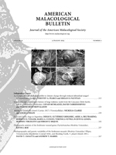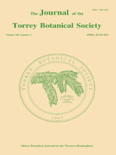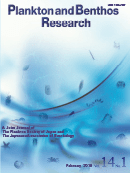
AMERICAN MALACOLOGICAL BULLETIN
Scope & Guideline
Connecting Scholars in the World of Mollusks.
Introduction
Aims and Scopes
- Molluscan Ecology and Distribution:
Research on the ecological aspects, distribution patterns, and population dynamics of mollusks in various environments, including freshwater and marine ecosystems. - Biodiversity and Conservation:
Studies aimed at documenting biodiversity within molluscan taxa and addressing conservation issues, particularly concerning threatened or invasive species. - Physiological and Behavioral Studies:
Investigations into the physiological responses and behaviors of mollusks, including feeding habits, reproductive strategies, and adaptations to environmental changes. - Molecular and Genetic Research:
Utilization of molecular techniques to explore genetic diversity, evolutionary relationships, and phylogenetics among molluscan species. - Historical and Paleontological Insights:
Research that incorporates historical data, including museum specimens, to understand the evolution and historical distribution of mollusks.
Trending and Emerging
- Freshwater Mollusks Research:
An increasing number of studies focus on freshwater mollusks, particularly their distribution, population dynamics, and conservation status, highlighting their ecological significance and the threats they face. - Gender Studies in Malacology:
Emerging themes around gender representation and roles within malacological research indicate a growing interest in the socio-cultural dimensions of science, as seen in studies addressing gender disparities in molluscan eponyms. - Applications of Molecular Techniques:
There is a rising trend in the use of molecular tools, such as DNA barcoding, to resolve taxonomic uncertainties and enhance understanding of genetic diversity, reflecting a broader shift towards molecular biology in the field. - Behavioral Ecology and Adaptations:
Recent publications have increasingly focused on the behavioral aspects of mollusks, including their responses to environmental cues and adaptations, which are crucial for understanding their survival and ecological roles. - Climate Change Impact Studies:
Research addressing the impacts of climate change on molluscan populations and ecosystems is gaining traction, underscoring the urgency of understanding how these organisms will respond to environmental changes.
Declining or Waning
- Invasive Species Impact Studies:
While still relevant, the frequency of studies specifically examining the ecological impacts of invasive molluscan species appears to be decreasing, possibly due to a saturation of knowledge or a shift towards more proactive conservation approaches. - Traditional Taxonomy and Systematics:
There seems to be a waning emphasis on purely traditional taxonomic studies as researchers increasingly incorporate molecular techniques and genetic analysis, which may overshadow classical taxonomy. - General Molluscan Physiology:
Broad studies on molluscan physiology without specific applications or ecological relevance have become less prominent, indicating a preference for more targeted research with direct implications for conservation or environmental management.
Similar Journals

REVISTA DE BIOLOGIA MARINA Y OCEANOGRAFIA
Navigating the Future of Marine BiologyREVISTA DE BIOLOGIA MARINA Y OCEANOGRAFIA is a prominent academic journal dedicated to the fields of marine biology and oceanography, published by the Faculty of Marine Sciences and Natural Resources at Universidad de Valparaíso, Chile. Since its inception in 1996, this journal has been a vital platform for disseminating research findings and advancements in aquatic sciences, covering a breadth of topics relevant to the marine environment. With its current impact positioned within the Q4 quartile of both Aquatic Science and Oceanography categories in 2023, the journal serves as an essential resource for scholars, practitioners, and students alike, aiming to enhance their understanding of marine ecosystems. While the journal does not provide open access options, it continues to contribute valuable insights, helping to foster a deeper appreciation for oceanographic science and marine biodiversity. Located in the scenic city of Viña del Mar, Chile, this publication invites manuscripts that push the boundaries of knowledge and stimulate discourse within the marine sciences community, thereby promoting sustainable management and conservation of oceanic resources.

Russian Journal of Biological Invasions
Illuminating the path to effective management strategies.Russian Journal of Biological Invasions, published by PLEIADES PUBLISHING INC, is a pioneering periodical dedicated to advancing the understanding of biological invasions in diverse ecological contexts. With an ISSN of 2075-1117 and an E-ISSN of 2075-1125, the journal primarily serves the scientific community in the fields of ecology, evolution, behavior, and systematics, boasting a respectable Q3 categorization in Ecology for 2023 and ranking 559 out of 721 in its domain in Scopus. The journal's coverage spans from 2010 to 2024, addressing critical issues such as the ecological impacts of invasive species and offering insights into management strategies. Though not an Open Access journal, it provides invaluable resources for researchers, professionals, and students keen on tackling the challenges posed by biological invasions. Its contributions significantly enrich the discourse in ecological research and conservation efforts, making it an essential resource for those seeking to comprehend and mitigate the effects of invasive species on ecosystems across the globe.

NAUTILUS
Advancing Aquatic Sciences for a Sustainable FutureNAUTILUS is a distinguished journal published by the Bailey-Matthews Shell Museum, dedicated to advancing the understanding of aquatic sciences as well as ecology, evolution, behavior, and systematics. With an ISSN of 0028-1344, NAUTILUS has played a significant role in the scholarly community from its inception, with publication converged between 1996 to 2015 and 2017 to 2024. Although currently categorized as Q4 in Aquatic Science and Ecology, Evolution, Behavior and Systematics for 2023, the journal has a reputation for publishing high-quality research that contributes to the broader scientific discourse. Researchers and students alike can benefit from the insights provided by NAUTILUS, which remains committed to exploring the intricate relationships within aquatic ecosystems. Its editorial management, led by Dr. José H. Leal, ensures rigorous peer review and academic excellence, making it a crucial resource for those dedicated to discovering the complexities of aquatic and ecological research.

CYBIUM
Advancing knowledge in ichthyology and aquatic sciences.CYBIUM is a reputable journal published by the Société Française d'Ichtyologie, dedicated to advancing research within the fields of Animal Science and Zoology as well as Ecology, Evolution, Behavior and Systematics. With a commitment to fostering scientific dialogue, CYBIUM has been a valuable resource for scholars since its inception in 1996, reporting on a wide array of ichthyological studies and aquatic biology. The journal is recognized in the 2023 Scopus rankings with a notable position in the Q3 quartile for Animal Science and Zoology and Q4 for Ecology, Evolution, Behavior and Systematics, reflecting its growing influence in these disciplines. Although currently not categorized as Open Access, CYBIUM continues to provide essential insights into fish biology and ecology from the heart of France, the Museum national d'Histoire naturelle in Paris. Researchers, professionals, and students in related fields will find CYBIUM an indispensable tool for staying informed about the latest developments and research trends within ichthyology and marine sciences.

JOURNAL OF THE TORREY BOTANICAL SOCIETY
Nurturing the future of plant science with every publication.JOURNAL OF THE TORREY BOTANICAL SOCIETY is a prominent academic journal dedicated to advancing the fields of botany and ecology, published by the esteemed TORREY BOTANICAL SOCIETY. With an ISSN of 1095-5674 and an E-ISSN of 1940-0616, this journal serves as a critical platform for researchers, professionals, and students to share their findings and insights. Despite its status in the Q4 category for the 2023 rankings across Ecology, Plant Science, and Ecology, Evolution, Behavior and Systematics, the journal continues to foster significant discourse and collaboration in the botanical sciences, aiming to elevate the understanding of plant biology and ecosystems. Its open access options enhance accessibility, ensuring that groundbreaking research reaches a wider audience. Published in the United States, the journal features work from both established scientists and emerging scholars, making it a vital resource for anyone involved in the study of plants and their environmental interactions. Explore the JOURNAL OF THE TORREY BOTANICAL SOCIETY to engage with cutting-edge research and contribute to the ongoing dialogue in the botanical sciences.

Revista de Sociedad Gaditana de Historia Natural
Documenting Nature's Wonders: A Gateway to UnderstandingRevista de Sociedad Gaditana de Historia Natural, published by the SOC GADITANA HISTORIA NATURAL, stands as a pivotal journal in the realm of natural history and environmental sciences. With the ISSN 1577-2578 and E-ISSN 2340-5759, this publication seeks to advance the understanding of biodiversity and ecosystems, particularly within the biodiverse regions of Cádiz, Spain. The journal fosters an open dialogue among researchers, professionals, and students, providing a platform for the dissemination of empirical findings, reviews, and theoretical discussions related to natural history. Although it operates under a non-open-access model, it is anticipated that the journal will play a crucial role in enhancing environmental awareness and promoting conservation efforts through high-quality scholarly contributions. The importance of documenting and understanding the intricate relationships within our ecosystems cannot be overstated, making this journal a valuable resource for anyone passionate about the natural world.

JOURNAL OF ORNITHOLOGY
Fostering Global Understanding of OrnithologyJOURNAL OF ORNITHOLOGY, published by Springer Heidelberg, is a leading international journal dedicated to the study of birds and their conservation. With an ISSN of 2193-7192 and an E-ISSN of 2193-7206, this journal serves as a crucial platform for disseminating innovative research focused on avian biology, ecology, and behavior, making significant contributions to the fields of Agricultural and Biological Sciences and Animal Science and Zoology, where it holds a commendable rank of #156 out of 490 in Scopus. Established from 2004 and continuing through 2024, the journal strives not only to advance academic scholarship but also to inform practical conservation efforts globally. While currently not open access, it remains a vital resource for researchers, professionals, and students seeking high-quality studies and findings that influence the understanding and preservation of bird species. The journal's commitment to excellence in science highlights its importance in ornithological research, offering insights that are both profound and actionable.

Plankton & Benthos Research
Illuminating the Interactions of Aquatic LifePlankton & Benthos Research, published by the Plankton Society of Japan, serves as a pivotal platform in the fields of Aquatic Science, Ecology, and Oceanography. With its inception in 2006 and ongoing publication until 2024, this esteemed journal focuses on the complex interactions within aquatic ecosystems, emphasizing the significance of plankton and benthic organisms in maintaining ecological balance. Although it is categorized in the Q3 quartile across several disciplines, it continues to provide valuable insights and a forum for researchers to share innovative findings and methodologies. The journal is not currently open access, which ensures a layer of curator-driven content quality. Its impact, measured through Scopus rankings, showcases its role in fostering knowledge exchange among academics and professionals engaged in ecological and environmental studies. With an ISSN of 1880-8247 and E-ISSN 1882-627X, Plankton & Benthos Research invites contributions that enhance our understanding of the aquatic realm, establishing itself as a crucial resource for ongoing research and advancement in these essential fields.

RAFFLES BULLETIN OF ZOOLOGY
Exploring Biodiversity Through Cutting-Edge ResearchRaffles Bulletin of Zoology, published by the National University of Singapore's Lee Kong Chian Natural History Museum, serves as a prestigious platform for the dissemination of cutting-edge research in Animal Science and Zoology, as well as Ecology, Evolution, Behavior and Systematics. With a current impact factor reflective of its Q2 category in both fields, this journal not only enhances its visibility in the academic community but also provides valuable insights into the complexities of biodiversity and conservation efforts. Covering a wide array of topics, Raffles Bulletin facilitates interdisciplinary collaboration and serves as an essential resource for researchers, professionals, and students alike. It is indexed in Scopus, ranking #233 out of 490 in Animal Science and Zoology and #406 out of 721 in Ecology, ensuring that the research published contributes significantly to the global discourse on wildlife and ecosystem management. Since its inception in 1996, this journal has bridged gaps in knowledge and continues to foster a deeper understanding of the living world.

PACIFIC CONSERVATION BIOLOGY
Empowering conservation through rigorous research and collaboration.PACIFIC CONSERVATION BIOLOGY is an esteemed academic journal published by CSIRO PUBLISHING, dedicated to advancing research in the fields of ecology and nature conservation. With a strong focus on the unique challenges and biodiversity of the Pacific region, this journal serves as a crucial platform for researchers, conservationists, and students alike to disseminate high-quality, impactful findings. Operating from Australia, it has become a significant resource since its inception in 1993, navigating through nearly three decades of vital scholarly communication. Ranked in the Q2 category for both Ecology and Nature and Landscape Conservation as of 2023, PACIFIC CONSERVATION BIOLOGY maintains rigorous standards, as reflected in its successful Scopus rankings. The journal plays a pivotal role in addressing pressing ecological issues and fostering innovative conservation strategies, making it an essential reference for anyone involved in environmental science. Access options for the journal facilitate widespread distribution of knowledge, supporting the mission to promote informed decision-making in conservation practices.